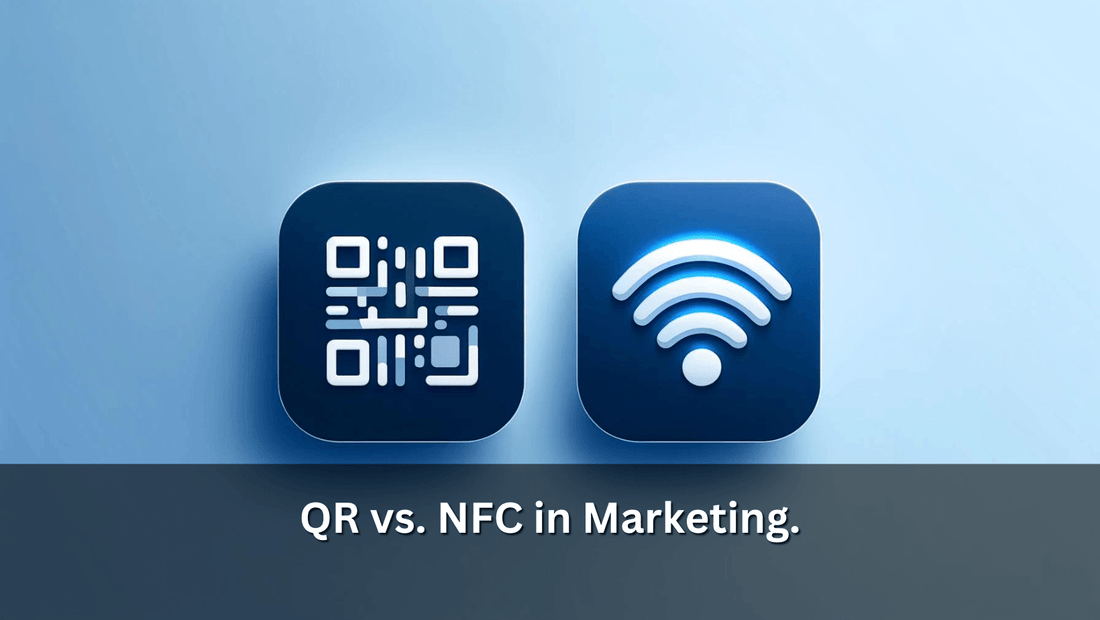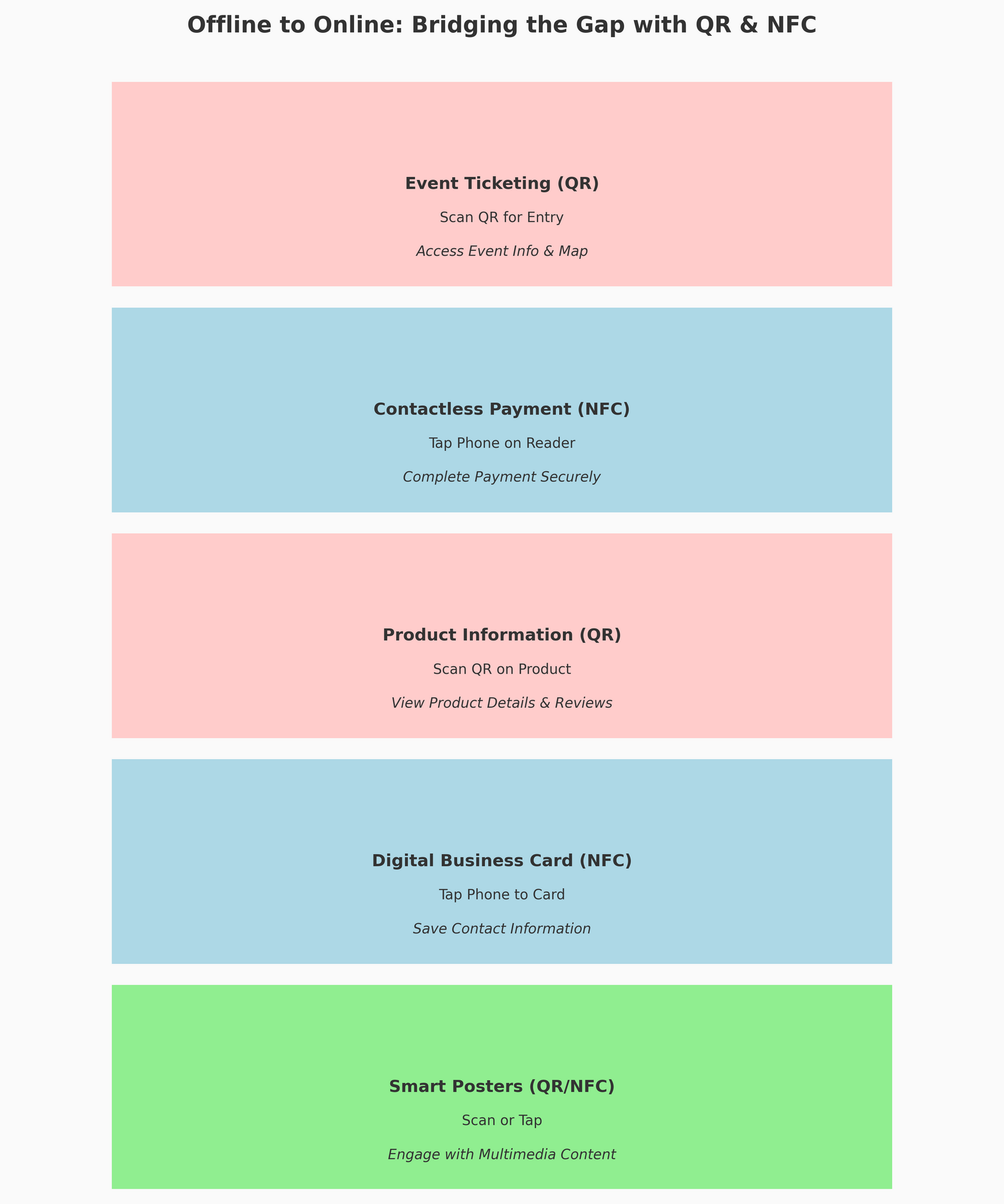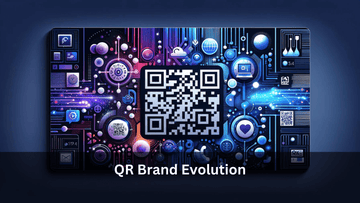QR vs. NFC in Marketing

Quick Scanning with QR
Quick Response (QR) codes, those square-shaped black-and-white symbols, have become ubiquitous in marketing strategies worldwide. Originally developed in Japan for the automotive industry, QR codes have transcended their initial purpose, offering a bridge between offline materials and online resources. Marketers have quickly adopted QR technology due to its simplicity and efficiency. By scanning a QR code with a smartphone camera, consumers can instantly access websites, videos, coupon codes, or any form of digital content. This immediate digital access transforms traditional marketing materials like posters, flyers, and business cards into interactive touchpoints. QR codes can effectively track engagement and gather data on consumer behavior, making them invaluable for personalized marketing campaigns. Their ease of creation and the minimal cost associated with them further contribute to their widespread adoption, enabling businesses of all sizes to leverage digital marketing tools effectively.
NFC: Just Tap ‘n Go
Near Field Communication (NFC) technology allows two devices to communicate when they are in close proximity, typically no more than a few centimeters apart. For marketers, NFC represents a seamless and interactive way to engage consumers through a simple tap. Unlike QR codes, which require a camera and a scanning action, NFC interactions are more intuitive and quicker, offering an almost instantaneous connection to digital content. This technology enables a wide range of marketing applications, from smart posters and interactive displays to product packaging that can store digital experiences directly on consumer goods.
NFC's unique advantage lies in its ability to create more personalized and secure interactions. Since NFC can initiate app-based actions on a smartphone, it opens up possibilities for more customized user experiences, including loyalty programs, secure payments, and exclusive content access. For marketers, the ease of use, higher engagement rates, and the sophistication of technology-enabled experiences make NFC a powerful tool in creating memorable brand interactions. Its ability to facilitate secure transactions also adds a layer of trust and value for consumers, further enhancing its appeal in marketing strategies.
NFC vs. QR: A Comparative Analysis
When comparing NFC (Near Field Communication) and QR (Quick Response) codes in marketing, several key factors come into play: accessibility, cost, user experience, and technology requirements.
Accessibility: QR codes have an edge in terms of accessibility. Almost every smartphone camera today can scan a QR code, making it universally accessible without the need for any additional hardware. On the other hand, NFC requires a smartphone with NFC capability, which, although common, is not universal.
Cost: Implementing QR codes is generally less expensive than NFC. QR codes can be generated at no cost and printed on any marketing material. NFC tags, however, involve a hardware component, making them more costly to produce and implement.
User Experience: NFC offers a more streamlined user experience. A simple tap can launch websites, apps, or videos, making the interaction effortless and quick. QR codes, while easy to use, require opening a camera app and scanning the code, which can be a slightly more cumbersome process.
Technology Requirements: QR codes only require a camera-equipped smartphone, making them highly compatible across devices. NFC's technology requirements are more stringent, as it requires both the consumer's device and the marketing medium to support NFC communication.
In summary, QR codes offer a more accessible and cost-effective solution for marketers, while NFC provides a superior user experience with its tap-and-go simplicity, albeit at a higher cost and with more specific technology requirements. For further insight into the evolving landscape of these technologies, consider exploring detailed analyses and expert opinions on TechCrunch and Wired.

The Hybrid Approach: Integrating QR and NFC
Adopting a hybrid approach that integrates both QR codes and NFC technologies can offer marketers the best of both worlds, enabling a more comprehensive and versatile marketing strategy. This approach leverages the universal accessibility of QR codes along with the seamless user experience provided by NFC, catering to a wider audience and enhancing engagement opportunities.
For instance, marketers can use QR codes for broad-reaching campaigns where cost-effectiveness and accessibility are key, such as on printed advertisements, product labels, and flyers. These codes can direct users to general information, promotional websites, or online contests, ensuring that anyone with a smartphone can engage.
Simultaneously, NFC tags can be integrated into more premium or location-specific interactions, such as in-store displays, event entrances, or on high-value products. NFC can offer a faster, more personalized interaction, ideal for loyalty programs, instant payments, or exclusive content, providing a touch of sophistication and convenience to the user experience.
By integrating both technologies, marketers can not only cater to the preferences and capabilities of a diverse consumer base but also collect a wider array of engagement data. This dual strategy enhances the customer journey, offering multiple touchpoints for interaction, and maximizes the reach and effectiveness of marketing campaigns.
Let's Put This into Practice
Real-world examples of successful QR and NFC marketing campaigns highlight the practical application and effectiveness of these technologies in engaging customers and driving business outcomes.
QR Code Campaign: Spotify & Genius - In a collaboration to enhance music discovery, Spotify and Genius launched a QR code campaign that allowed users to scan codes on select Spotify posters. Scanning these codes led users to "Behind the Lyrics" playlists, offering a deeper connection with the music and artists they love, thereby increasing user engagement and time spent on the app.
NFC Campaign: Adidas & NFC Sneakers - Adidas incorporated NFC tags in certain sneaker models, which, when tapped with a smartphone, unlocked exclusive content, including product history, authenticity verification, and special promotions. This not only enriched the customer experience but also strengthened brand loyalty and authenticity, showcasing the seamless integration of NFC technology into consumer products.
These campaigns demonstrate how QR codes and NFC can be creatively used to bridge the gap between physical and digital worlds, enhancing brand interaction and customer engagement. For more insights into effective marketing strategies and case studies on QR and NFC technologies, visiting HubSpot's Blog can provide valuable information and inspiration.
Offline to Online: Bridging the Gap
QR codes and NFC technology excel in seamlessly transitioning users from offline to online environments. QR codes can be printed on almost any surface, allowing consumers to scan and instantly access a website, video, or app, thus bridging the physical and digital divide. NFC tags, embedded in posters or products, facilitate a similar transition with a simple tap. These technologies enable direct engagement with digital content from physical objects, enhancing the marketing mix by linking tangible products or advertisements with online resources, social media campaigns, or e-commerce platforms, effectively expanding the reach and interactivity of traditional marketing efforts.

Device to Device: Simplifying Interactions
NFC shines in enabling direct device-to-device communication, offering a smooth and intuitive way for data exchange. For example, payment transactions between a smartphone and a point-of-sale system are made efficient and secure through NFC, eliminating the need for physical credit cards. Similarly, information sharing between devices, like contacts or photos, can be accomplished by simply tapping two NFC-enabled smartphones together. This facilitates not just easier transactions but also encourages innovative marketing strategies, such as instant coupon redemption or digital business cards, thereby streamlining interactions and enhancing the customer experience.
The Impact on Sales: Tracking and Conversion
The integration of QR codes and NFC into marketing strategies significantly impacts sales tracking and conversion rates. QR codes allow for the precise tracking of user engagement from various offline sources, providing valuable insights into campaign effectiveness and consumer behavior. NFC, with its capability for more personalized interactions, can enhance customer loyalty and repeat purchases through tailored experiences and offers. These technologies not only facilitate a direct pathway to purchase by simplifying the buying process but also enable marketers to collect data on preferences and habits, leading to optimized strategies and a noticeable boost in sales conversion rates.
Review and Future Outlook
In review, QR codes and NFC represent versatile and powerful tools in the modern marketing arsenal, offering unique advantages in accessibility, engagement, and data analytics. As we look to the future, the integration of these technologies is poised to deepen, driven by advancements in smartphone capabilities and consumer demand for seamless, interactive experiences. Emerging trends, such as augmented reality (AR) experiences triggered by QR codes and NFC, are set to offer even more immersive and personalized marketing opportunities. The continued evolution of these technologies will undoubtedly open new horizons for engaging customers, shaping the future of digital and physical marketing landscapes.
We at NFC Tagify provide all sort of NFC Solutions or you may contact us: Tel. 01600800080, Email: info@nfctagify.com








